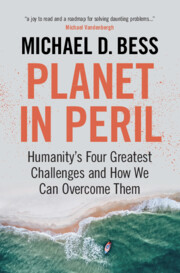Book contents
- Planet in Peril
- Reviews
- Planet in Peril
- Copyright page
- Dedication
- Epigraph
- Contents
- Fictional Vignettes
- Acknowledgements
- 1 Introduction
- Part I Existential Threats: The Four Most Pressing Dangers Facing Humankind
- Part II Strategies and Obstacles: The Solutions We Need, and What’s Preventing Them from Being Realized
- Part III Sensible Steps for Today’s World: Powerful Measures We Can Implement Right Away
- 10 Do It Now: Five Points of Leverage
- 11 Constructive Moves on the International Front for the Next 25 Years
- 12 Breaking the Political Logjam
- 13 Lessons from the Green Movement: How to Build Lasting Change in the Absence of Full Consensus
- Part IV The Middle-Term Goal: New International Tools for the Late Twenty-First Century
- Part V The Long-Term Goal: Envisioning a Mature System of Global Governance for the Twenty-Second Century
- Endnotes
- Bibliography
- Index
13 - Lessons from the Green Movement: How to Build Lasting Change in the Absence of Full Consensus
from Part III - Sensible Steps for Today’s World: Powerful Measures We Can Implement Right Away
Published online by Cambridge University Press: 13 October 2022
- Planet in Peril
- Reviews
- Planet in Peril
- Copyright page
- Dedication
- Epigraph
- Contents
- Fictional Vignettes
- Acknowledgements
- 1 Introduction
- Part I Existential Threats: The Four Most Pressing Dangers Facing Humankind
- Part II Strategies and Obstacles: The Solutions We Need, and What’s Preventing Them from Being Realized
- Part III Sensible Steps for Today’s World: Powerful Measures We Can Implement Right Away
- 10 Do It Now: Five Points of Leverage
- 11 Constructive Moves on the International Front for the Next 25 Years
- 12 Breaking the Political Logjam
- 13 Lessons from the Green Movement: How to Build Lasting Change in the Absence of Full Consensus
- Part IV The Middle-Term Goal: New International Tools for the Late Twenty-First Century
- Part V The Long-Term Goal: Envisioning a Mature System of Global Governance for the Twenty-Second Century
- Endnotes
- Bibliography
- Index
Summary
This chapter offers the story of the green movement since the 1950s as a case study in how to bring about deep and lasting societal change in the absence of full political consensus. Over the past 60 years, green activists have not succeeded in fully realizing their goal of a sustainable economic system, but they have succeeded in bringing pervasive changes to modern economic, social, and energy systems. By pursuing an eclectic, decentralized, and multifaceted set of strategies over many decades, they have made a significant positive impact. A similar strategy is likely to work best for building new systems of global governance for mega-dangerous technologies. Climate change may prove to be a uniquely potent unifying factor for humankind over the coming decades, allowing effective mobilization for incremental reforms. The reasons for this are threefold: climate change is not subject to the logic of arms races; it threatens to bring tangible harms that affect all human beings; and its disasters will escalate gradually over the coming decades, giving people a chance to wake up and respond constructively.
Keywords
- Type
- Chapter
- Information
- Planet in PerilHumanity's Four Greatest Challenges and How We Can Overcome Them, pp. 185 - 196Publisher: Cambridge University PressPrint publication year: 2022



